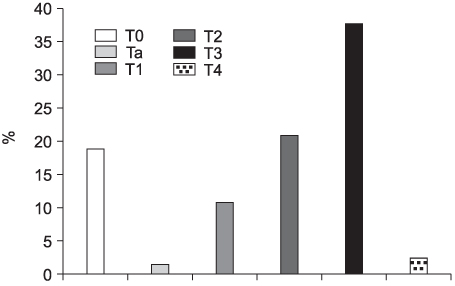Korean J Urol.
2007 Apr;48(4):390-395. 10.4111/kju.2007.48.4.390.
Predictive Factors of Advancement of the Pathologic T Stage after Radical Cystectomy in Patients with Clinical T2 Stage Bladder Transitional Cell Carcinoma
- Affiliations
-
- 1Department of Urology, Sungkyunkwan University School of Medicine, Seoul, Korea. besthml@ medimail.co.kr
- KMID: 1997105
- DOI: http://doi.org/10.4111/kju.2007.48.4.390
Abstract
- PURPOSE
We wanted to identify the predictive factors of pathologic over- staging in a homogeneous series of patients who had undergone radical cystectomy for their clinical T2 stage bladder cancer.
MATERIALS AND METHODS
We retrospectively analyzed the clinicopathological parameter of 53 patients who had undergone radical cystectomy for the management of muscle-invasive transitional cell carcinoma. Of these 53 patients, 44 were men and 9 were women. The mean age was 61.3 years. After dividing the entire cohort into 2 groups according to final pathologic stage (> or = pT3 and < or = pT2), we compared the clinicopathological parameters such as the time interval between the initial diagnosis of muscle invasion and cystectomy, the number of transurethral resection of bladder tumors (TURBTs), intravesical immunochemotherapy, the tumor grade, the p53 expression, the presence of carcinoma in situ and the gross findings of transurethral resection of bladder tumor (i.e. tumor size, multiplicity and tumor configuration) between the 2 groups.
RESULTS
The final pathologic stages were < or = pT2 in 31 patients (58.5%), pT3 in 20 patients (37.7%) and pT4 in 2 patients (3.8%). Comparison of the clinical staging with the pathological staging revealed that 22 of the 53 cases (41.5%) were clinically understaged. There were no statistically significant differences between the > or = pT3 and < or = pT2 groups regarding the number of TURBTs, intravesical immunochemotheraphy, tumor grade, the p53 expression, the presence of carcinoma in situ and the gross findings of TURBT. But patients with a time interval of > or = 2 months between the diagnosis of muscle invasion and cystectomy had a significantly higher frequency of extravesical disease.
CONCLUSIONS
These results underline the need for early treatment with cystectomy, within a 2 month period, once the diagnosis of muscle invasion has been made.
Keyword
MeSH Terms
Figure
Reference
-
1. Kim WJ, Chung JI, Hong JH, Kim CS, Jung SI, Yoon DK. Epidemiological study for urologic cancer in Korea (1998-2002). Korean J Urol. 2004. 45:1081–1088.2. Kaye KW, Lange PH. Mode of presentation of invasive bladder cancer: reassessment of the problem. J Urol. 1982. 128:31–33.3. Babaian RJ, Johnson DE, Llamas L, Ayala AG. Metastases from transitional cell carcinoma of urinary bladder. Urology. 1980. 16:142–144.4. Bayraktar Z, Gurbuz G, Tasci AI, Sevin G. Staging error in the bladder tumor: the correlation between stage of TUR and cystectomy. Int Urol Nephrol. 2001. 33:627–629.5. Ficarra V, Dalpiaz O, Alrabi N, Novara G, Galfano A, Artibani W. Correlation between clinical and pathological staging in a series of radical cystectomies for bladder carcinoma. BJU Int. 2005. 95:786–790.6. Skinner DG, Crawford ED, Kaufman JJ. Complications of radical cystectomy for carcinoma of the bladder. J Urol. 1980. 123:640–643.7. MacVicar AD. Bladder cancer staging. BJU Int. 2000. 86:Suppl 1. 111–122.8. Koss JC, Arger PH, Coleman BG, Mulhern CB Jr, Pollack HM, Wein AJ. CT staging of bladder carcinoma. AJR Am J Roentgenol. 1981. 137:359–362.9. Lee SE, Choi BI, Kim CS. The role of CT in staging bladder carcinoma. Korean J Urol. 1985. 26:19–24.10. Kim JK, Park SY, Ahn HJ, Kim CS, Cho KS. Bladder cancer: analysis of multi-detector row helical CT enhancement pattern and accuracy in tumor detection and perivesical staging. Radiology. 2004. 231:725–731.11. Kim B, Semelka RC, Ascher SM, Chalpin DB, Carroll PR, Hricak H. Bladder tumor staging: comparison of contrast-enhanced CT, T1- and T2-weighted MR imaging, dynamic gadolinium-enhanced imaging, and late gadolinium-enhanced imaging. Radiology. 1994. 193:239–245.12. Hautmann RE, Paiss T. Does the option of the ileal neobladder stimulate patient and physician decision toward earlier cystectomy? J Urol. 1998. 159:1845–1850.13. Chang SS, Hassan JM, Cookson MS, Wells N, Smith JA Jr. Delaying radical cystectomy for muscle invasive bladder cancer results in worse pathological stage. J Urol. 2003. 170:1085–1087.14. Sanchez-Ortiz RF, Huang WC, Mick R, Van Arsdalen KN, Wein AJ, Malkowicz SB. An interval longer than 12 weeks between the diagnosis of muscle invasion and cystectomy is associated with worse outcome in bladder carcinoma. J Urol. 2003. 169:110–115.15. May M, Nitzke T, Helke C, Vogler H, Hoschke B. Significance of the time period between diagnosis of muscle invasion and radical cystectomy with regard to the prognosis of transitional cell carcinoma of the urothelium in the bladder. Scand J Urol Nephrol. 2004. 38:231–235.16. Lee CT, Madii R, Daignault S, Dunn RL, Zhang Y, Montie JE, et al. Cystectomy delay more than 3 months from initial bladder cancer diagnosis results in decreased disease specific and overall survival. J Urol. 2006. 175:1262–1267.17. Cheng L, Weaver AL, Leibovich BC, Ramnani DM, Neumann RM, Scherer BG, et al. Predicting the survival of bladder carcinoma patients treated with radical cystectomy. Cancer. 2000. 88:2326–2332.18. Thomas DJ, Roberts JT, Hall RR, Reading J. Radical transurethral resection and chemotherapy in the treatment of muscle-invasive bladder cancer: a long-term follow-up. BJU Int. 1999. 83:432–437.19. Kageyama Y, Okada Y, Arai G, Hyochi N, Suzuki M, Masuda H, et al. Preoperative concurrent chemoradiotherapy against muscle-invasive bladder cancer: results of partial cystectomy in elderly or high-risk patients. Jpn J Clin Oncol. 2000. 30:553–556.20. Cheng L, Weaver AL, Bostwick DG. Predicting extravesical extension of bladder carcinoma: a novel method based on micrometer measurement of the depth of invasion in transurethral resection specimens. Urology. 2000. 55:668–672.
- Full Text Links
- Actions
-
Cited
- CITED
-
- Close
- Share
- Similar articles
-
- The significance of positivity of proliferating cell nuclear antigen in transitional cell carcinoma of the bladder
- Pathologic Features of Recurrent Bladder Tumors after Upper Urinary Tract Transitional Cell Carcinoma
- Transitional cell carcinoma of the bladder: survival rates and prognostic factors
- The Impact of Transurethral Resection of Bladder Tumor: Clinicopathologic Analysis of Cystectomy Specimen to Evaluate Residual Tumor
- Urethral Recurrence of Bladder Tumor after Total Cystectomy


